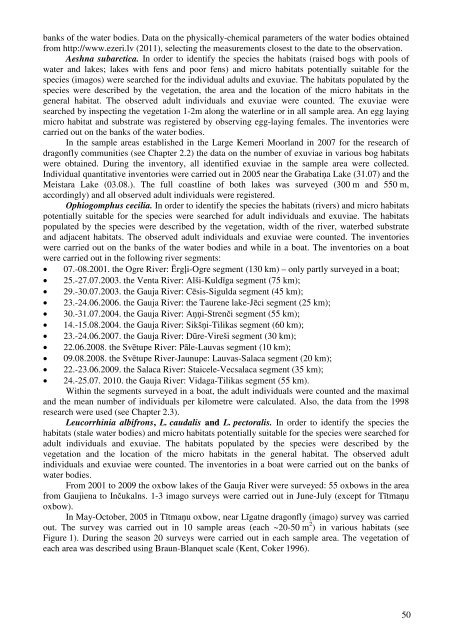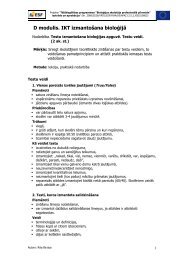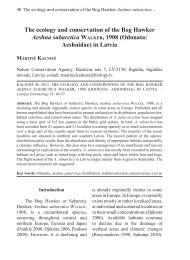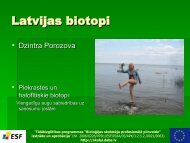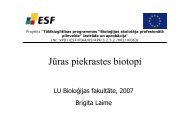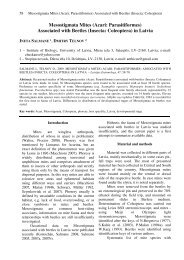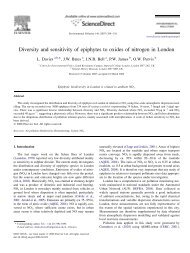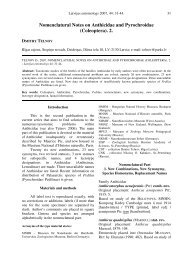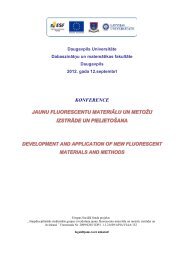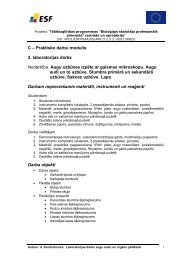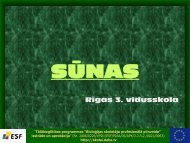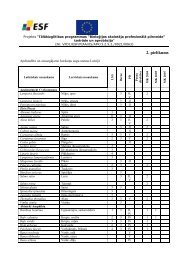Odonata - Entomological Society of Latvia - Latvijas Daba
Odonata - Entomological Society of Latvia - Latvijas Daba
Odonata - Entomological Society of Latvia - Latvijas Daba
You also want an ePaper? Increase the reach of your titles
YUMPU automatically turns print PDFs into web optimized ePapers that Google loves.
anks <strong>of</strong> the water bodies. Data on the physically-chemical parameters <strong>of</strong> the water bodies obtained<br />
from http://www.ezeri.lv (2011), selecting the measurements closest to the date to the observation.<br />
Aeshna subarctica. In order to identify the species the habitats (raised bogs with pools <strong>of</strong><br />
water and lakes; lakes with fens and poor fens) and micro habitats potentially suitable for the<br />
species (imagos) were searched for the individual adults and exuviae. The habitats populated by the<br />
species were described by the vegetation, the area and the location <strong>of</strong> the micro habitats in the<br />
general habitat. The observed adult individuals and exuviae were counted. The exuviae were<br />
searched by inspecting the vegetation 1-2m along the waterline or in all sample area. An egg laying<br />
micro habitat and substrate was registered by observing egg-laying females. The inventories were<br />
carried out on the banks <strong>of</strong> the water bodies.<br />
In the sample areas established in the Large Kemeri Moorland in 2007 for the research <strong>of</strong><br />
dragonfly communities (see Chapter 2.2) the data on the number <strong>of</strong> exuviae in various bog habitats<br />
were obtained. During the inventory, all identified exuviae in the sample area were collected.<br />
Individual quantitative inventories were carried out in 2005 near the Grabatiņa Lake (31.07) and the<br />
Meistara Lake (03.08.). The full coastline <strong>of</strong> both lakes was surveyed (300 m and 550 m,<br />
accordingly) and all observed adult individuals were registered.<br />
Ophiogomphus cecilia. In order to identify the species the habitats (rivers) and micro habitats<br />
potentially suitable for the species were searched for adult individuals and exuviae. The habitats<br />
populated by the species were described by the vegetation, width <strong>of</strong> the river, waterbed substrate<br />
and adjacent habitats. The observed adult individuals and exuviae were counted. The inventories<br />
were carried out on the banks <strong>of</strong> the water bodies and while in a boat. The inventories on a boat<br />
were carried out in the following river segments:<br />
• 07.-08.2001. the Ogre River: Ērgļi-Ogre segment (130 km) – only partly surveyed in a boat;<br />
• 25.-27.07.2003. the Venta River: Alši-Kuldīga segment (75 km);<br />
• 29.-30.07.2003. the Gauja River: Cēsis-Sigulda segment (45 km);<br />
• 23.-24.06.2006. the Gauja River: the Taurene lake-Jēci segment (25 km);<br />
• 30.-31.07.2004. the Gauja River: Aņņi-Strenči segment (55 km);<br />
• 14.-15.08.2004. the Gauja River: Sikšņi-Tilikas segment (60 km);<br />
• 23.-24.06.2007. the Gauja River: Dūre-Vireši segment (30 km);<br />
• 22.06.2008. the Svētupe River: Pāle-Lauvas segment (10 km);<br />
• 09.08.2008. the Svētupe River-Jaunupe: Lauvas-Salaca segment (20 km);<br />
• 22.-23.06.2009. the Salaca River: Staicele-Vecsalaca segment (35 km);<br />
• 24.-25.07. 2010. the Gauja River: Vidaga-Tilikas segment (55 km).<br />
Within the segments surveyed in a boat, the adult individuals were counted and the maximal<br />
and the mean number <strong>of</strong> individuals per kilometre were calculated. Also, the data from the 1998<br />
research were used (see Chapter 2.3).<br />
Leucorrhinia albifrons, L. caudalis and L. pectoralis. In order to identify the species the<br />
habitats (stale water bodies) and micro habitats potentially suitable for the species were searched for<br />
adult individuals and exuviae. The habitats populated by the species were described by the<br />
vegetation and the location <strong>of</strong> the micro habitats in the general habitat. The observed adult<br />
individuals and exuviae were counted. The inventories in a boat were carried out on the banks <strong>of</strong><br />
water bodies.<br />
From 2001 to 2009 the oxbow lakes <strong>of</strong> the Gauja River were surveyed: 55 oxbows in the area<br />
from Gaujiena to Inčukalns. 1-3 imago surveys were carried out in June-July (except for Tītmaņu<br />
oxbow).<br />
In May-October, 2005 in Tītmaņu oxbow, near Līgatne dragonfly (imago) survey was carried<br />
out. The survey was carried out in 10 sample areas (each ~20-50 m 2 ) in various habitats (see<br />
Figure 1). During the season 20 surveys were carried out in each sample area. The vegetation <strong>of</strong><br />
each area was described using Braun-Blanquet scale (Kent, Coker 1996).<br />
50


